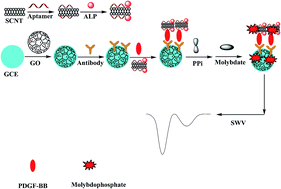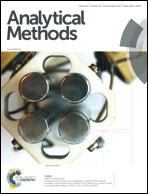Dual signal amplification strategy for electrochemical detection of platelet-derived growth factor BB
Abstract
The authors report a dual signal amplification strategy for improving the sensitivity of an electrochemical immunosensor. Single-walled carbon nanotubes (SCNTs) served as supports for aptamers and alkaline phosphatase (ALP), and then the modified SCNTs were utilized as electrochemical probes. The aptamer contains phosphate groups, while ALP can hydrolyse one molecular pyrophosphate into two molecular phosphate ions. The phosphate can react with molybdate to form a redox-active molybdophosphate precipitate on the surface of the glassy carbon electrode (GCE). With applying a relatively low voltage of 0.21 V (vs. Ag/AgCl), the generated electrochemical current intensity is proportional to the concentration of the analyte. The cancer biomarker platelet-derived growth factor BB (PDGF-BB) was chosen as a model antigen (analyte). The immunosensor was prepared by sequential capturing of the antibodies against PDGF-BB, analyte (PDGF-BB) and modified SCNTs on the GCE to form a sandwich structure. The current signal is linear in the concentration range of 0.1 pg mL−1 to 50 ng mL−1 PDGF-BB, with a detection limit as low as 50 fg mL−1. The immunosensor was finally applied in the determination of PDGF-BB concentration in serum samples. Our perception is that this signal amplification strategy can be adapted to the preparation of other immunosensors and will find wide applications in the detection of different biomarkers and related species.



 Please wait while we load your content...
Please wait while we load your content...